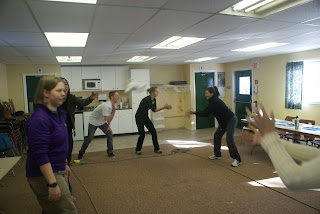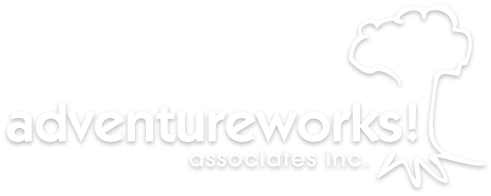Letting Go: The Power of Letting the Group Decide
/
Recently I was working with a student success type program where some of the youth would be what you might call "disengaged." This group of high school students were participating in this one-day workshop with the intent of building positive connections with each other and hopefully this would help them to engage, or re-engage in school.
I started the workshop with my typical warm-up activities that not only allow students to connect and get a feel for my style, they also allow me to do a little group diagnostics which helps me choose the right "next" activity, or sequence of activities. Through my diagnostic process of activities, I decided that I would eventually use an activity called Mass Pass.
Now Mass Pass is not for every group as it can be frustrating and challenging, and it does require the group to be persistent, set goals, and be committed to their plan: some nice transfers to school I thought. So the general idea of Mass Pass is that there is a giant rope rectangle where the group is spread out along. There are two buckets full of stuff at opposite corners of the rectangle. The items from bucket "A" must successfully find their way to bucket "B" and vise-a-verse-a. Each item has to pass through each person's hands at least once and you can't pass things to someone on the same plane of the rope as you are on. Obviously people are stationary and can't enter the inside of the shape. All this without dropping items and as fast as humanly possible. (there may be a few more finer details but you get the idea)

So the group had a few unsuccessful attempts and then I prompted them to set a time goal. They came to consensus on how fast they think they could successfully complete it. And so they tried again, and again, and again, each time getting a little closer to their time, but still dropping items. After about the 5th try a few students were getting a bit frustrated and one student said that they should just quit. I asked the group what was working well and if they would like to change anything. The student who was adamant they should quit asked if they could shrink the rectangle.
So there is a choice here for me now: do I say no, these are the rules you must live within, or do I let them attempt this idea and change the dynamic and potential outcome of the activity. Well I did the latter. The student who was going to give up lead the change, they attempted the task again and found it much harder. So what happened next was the student who wanted to shrink the shape, and convinced the whole group to do so, took ownership for the idea not working and suggested they go back to the original format.
What really happened was a transfer of power. I handed the power over to the group. Groups perceive we as facilitators have power, and we often do. The perception of this power shift allowed the group to take more ownership over the task and it actually engaged them more. It engaged them so much that they would not stop the activity until their goal was achieved, which they succeeded in doing.
This shift in power also engaged that "disengaged" student who was going to quit and walk away. In fact that student had some fantastic things to say in our debrief and made some great transfer of learning when we talked about structure, why it exists, needing understanding, power to make choices, and achieving goals. One of the most powerful connections was the idea that sometimes students are disengaged from, or "check-out" of school as they feel like they lack power over their situation when sometimes it might just be their perception.
Wow, all this from one activity! This prompted me to reflect that sometimes I don't hand over the power, or the rules of the activity to the group when I should. I might get lost in the activity when really the activity is about the outcomes that will happen and the transfer of learning. Letting the group decide can be a very powerful learning opportunity.
I started the workshop with my typical warm-up activities that not only allow students to connect and get a feel for my style, they also allow me to do a little group diagnostics which helps me choose the right "next" activity, or sequence of activities. Through my diagnostic process of activities, I decided that I would eventually use an activity called Mass Pass.
Now Mass Pass is not for every group as it can be frustrating and challenging, and it does require the group to be persistent, set goals, and be committed to their plan: some nice transfers to school I thought. So the general idea of Mass Pass is that there is a giant rope rectangle where the group is spread out along. There are two buckets full of stuff at opposite corners of the rectangle. The items from bucket "A" must successfully find their way to bucket "B" and vise-a-verse-a. Each item has to pass through each person's hands at least once and you can't pass things to someone on the same plane of the rope as you are on. Obviously people are stationary and can't enter the inside of the shape. All this without dropping items and as fast as humanly possible. (there may be a few more finer details but you get the idea)
So the group had a few unsuccessful attempts and then I prompted them to set a time goal. They came to consensus on how fast they think they could successfully complete it. And so they tried again, and again, and again, each time getting a little closer to their time, but still dropping items. After about the 5th try a few students were getting a bit frustrated and one student said that they should just quit. I asked the group what was working well and if they would like to change anything. The student who was adamant they should quit asked if they could shrink the rectangle.
So there is a choice here for me now: do I say no, these are the rules you must live within, or do I let them attempt this idea and change the dynamic and potential outcome of the activity. Well I did the latter. The student who was going to give up lead the change, they attempted the task again and found it much harder. So what happened next was the student who wanted to shrink the shape, and convinced the whole group to do so, took ownership for the idea not working and suggested they go back to the original format.
What really happened was a transfer of power. I handed the power over to the group. Groups perceive we as facilitators have power, and we often do. The perception of this power shift allowed the group to take more ownership over the task and it actually engaged them more. It engaged them so much that they would not stop the activity until their goal was achieved, which they succeeded in doing.
This shift in power also engaged that "disengaged" student who was going to quit and walk away. In fact that student had some fantastic things to say in our debrief and made some great transfer of learning when we talked about structure, why it exists, needing understanding, power to make choices, and achieving goals. One of the most powerful connections was the idea that sometimes students are disengaged from, or "check-out" of school as they feel like they lack power over their situation when sometimes it might just be their perception.
Wow, all this from one activity! This prompted me to reflect that sometimes I don't hand over the power, or the rules of the activity to the group when I should. I might get lost in the activity when really the activity is about the outcomes that will happen and the transfer of learning. Letting the group decide can be a very powerful learning opportunity.


